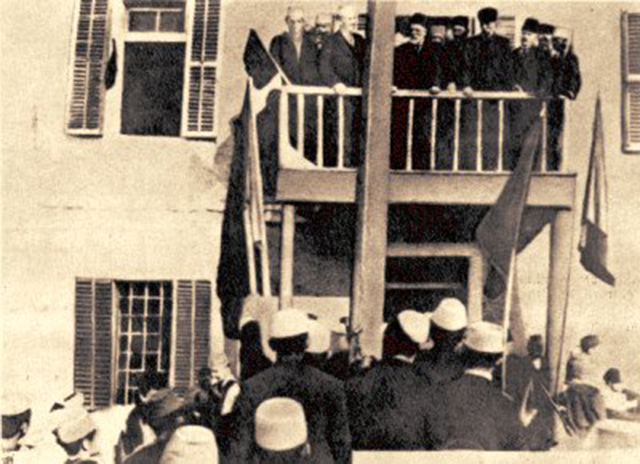Flags with a black two-headed eagle on red background could be seen waving today on Times Square.
By Ruben Avxhiu
On November 28th, 2012, Albanians all over the world celebrate the 100th anniversary of their Declaration of Independence, the act that officially ended five hundred years of Ottoman occupation.
Flags with a black two-headed eagle on red background could be seen waving today on Times Square. At least a couple hundreds of thousands Albanian-Americans live in the Tristate area and many call New York City their home. They are often working in real estate, construction, restaurants and building maintenance, but also in banking, finance, sports and entertainment. Chances are you have met some of them in neighborhoods and towns, at work or playgrounds. You may have heard of actors like John and Jim Belushi, TV personalities like Regis Philbin, astronauts like William Gregory, scientists like Nobel Prize winner Ferid Murad, engineers like William Kokalari (Apollo 11 of the first man on the Moon) etc.
Albanians are one of the oldest people in Europe, the only survivals of the Illyrian tribes – northern neighbors of Ancient Greeks. The Albanian currency, Lek, was named after Alexander the Great.
Albanians called themselves Shqiptarë (Schipatar) which mean “of the eagle” or “sons of the eagles”. Probably because just like eagles, over long centuries, they found refuge in the highest mountains, opting for a tough impossible life in freedom rather than submit to foreign invaders.
November 28th is more than the “Albanian 4th of July”.
On November 28th, 1443 George Kastrioti Skanderbeg, our national hero took back the castle of Kruja from the Ottomans and led the Albanian resistance against the most powerful empire of the time for a quarter of century. The West owes its survival also to this small but proud nation that stopped the momentum of the swelling oriental tide from taking over Rome as they had done with Constantinople.
It was again November 28th when in 1912, Albania declared independence challenging plans of its Slavic and Greek neighbors to divide its lands among them. Yet, more than half of the Albanian population was left outside the borders of the new state. Albanians live today in Albania, Kosova (90%), Macedonia (30%), Montenegro, Greece and Serbia. Hundreds of thousands, known as Arbëresh, live in Italy, where they immigrated after the death of their leader, Skanderbeg, as the Ottomans swept over their country. Many immigrated later to the US, often living amid Italian-American communities.
Again on November 28th, 1944, Albania became the only country in Europe to liberate itself from the Nazi occupation without the help of ground troops from the Allies.
And in a further nod to this fateful date, on November 28th, 1997, Kosova Liberation Army showed for the first time in public. They fought valiantly to defend their Albanian population from ethnic cleansing and terrorism of the Serbian dictatorship regime of Slobodan Milosevic, in a war that ended with the intervention of NATO. Today, Kosova is an independent country too.
Albanians are famous for their interreligious harmony. They are mostly Muslim, Christian Orthodox and Roman Catholics, but there are also Jews, a growing number of Protestants and other organized faiths among them. This is the land, where St Paul preached and wrote his Roman Letters; the land that gave birth to the first Pope, Emperor Constantine who Christianized Rome and the West. However this is also the only country in Europe with a Muslim majority and the only one where the Jewish population grew during WWII. Despite the Nazi occupation, Albania saved 100% of its Jewish population and provided passports and refuge to hundreds of others who had no other way of escaping from Europe to US. Albert Einstein was one of them. The most famous Albanian is Mother Teresa (Gonxhe Bojaxhiu), the extraordinary great little nun, the humanitarian who won the Nobel Prize for Peace and the hearts of people all over the world.
In no other country is the US more loved than in Albania. After the WWI, President Woodrow Wilson defended the independence of Albania, when many European powers were content to let Balkans neighbors divide this small country among them. When President Ronald Reagan said: “Mr. Gorbachev tear down this wall” it was a signal also to the Albanian nation that the end of communism was near. President Bill Clinton ordered the intervention in Kosova and saved the ethnic-Albanian population from a humanitarian catastrophe and genocide in one of the last colonized countries in the world. In 2007, George W Bush became the first US President to visit Albania. He was greeted as a rock star. In 2008, Kosova declared its independence and the United States of America led the wave of recognitions all over the world.
A few weeks ago, Secretary of State, Hillary Clinton speaking in front of the Albanian parliament in Tirana, she said: “The United States stood with you for your first 100 years of independence, and we will stand with you for the next 100, and the 100 after that, and the 100 after that.”
No wonder, Albanian-Americans are among the most proud US citizens in their communities. They found in this country freedoms and possibilities that had been denied to them over the centuries. They are among the most likely to have an American flag in their windows, balconies or porches. They are your good friends and neighbors, hard-working, family-oriented law-abiding citizens who have played a role in the revival of many US towns and cities. They are the ones celebrating today the first century of their long due independence, celebrating their survival against all odds, happy to live in the greatest country of the world and you are all invited to join their well-deserved moment of pride and joy.
(A version of this text was published by The New York Daily News, on November 28th, 2012, as the opening piece of a 40-page supplement dedicated to the 100th anniversary of Albania’s independence.)
